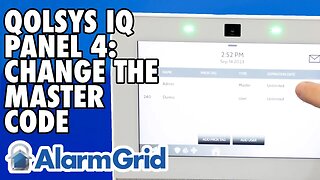Premium Only Content

Using Wired Contacts on a 2GIG GC3
In this video, Joe talks about using a hardwired alarm contact with the 2GIG GC3 Alarm System. There are a few different ways that a user can do this. The panel actually has two inputs for normally closed hardwired devices. A user can also use a wired to wireless converter or a wireless transmitter.
If a user only plans on using one or two hardwired devices with their GC3 System, the easiest option is to usually just connect them to the terminals on the back. The system will support normally closed hardwired sensors in this manner. These terminals are appropriately labeled "Zone 1" and "Zone 2". There is also a separate ground terminal labeled "GND" that will be used for these two sensors The two wired contacts that are used in this way are set up with the system through the "Wired Zones" menu of System Configuration.
The other two methods for using hardwired door and window contacts with the 2GIG GC3 Control Panel involve setting them up with wireless zones on the system. This can be done with either a wired to wireless converter or a wireless transmitter. In either case, the hardwired contact will rely on another device to send wireless communication signals to the GC3 System on its behalf. The GC3 Alarm System will recognize the hardwired contact as a wireless device. It will be set up with one of the wireless zones on the system.
A wired to wireless converter will allow multiple wired contacts to communicate with the GC3 System wirelessly. The hardwired devices will connect directly with the converter. The converter will then send a wireless signal to the system on the behalf of the sensor. Each sensor will have its own wireless zone on the system. The converter must speak at a frequency that is compatible with the system. In the case of the GC3, the 345 MHz frequency is used. Some examples of compatible wired to wireless converters for the 2GIG GC3 include the Honeywell 5800C2W and the 2GIG TAKE-345.
A wireless transmitter follows a similar principle as a wired to wireless converter. But a major difference between the two is that a wired to wireless converter will allow resistors to be used, while most wireless transmitters will not. Also wired to wireless converters generally support a greater number of wired contacts than a transmitter. Just like with a wired to wireless converter, the hardwired contact will connect directly with the transmitter, and the transmitter will communicate wirelessly on the behalf of the contact. Many wireless transmitters also perform additional tasks beyond supporting normally closed hardwired contacts. An example is the Honeywell 5819, which serves as a wireless transmitter, a door and window contact and as a shock sensor.
-
 4:37
4:37
Alarm Grid Home Security DIY Videos
2 years agoQolsys IQ Panel 4: Change the Master Code
33 -
 LIVE
LIVE
Joker Effect
11 minutes ago"MAKE STREAMING GREAT AGAIN" - Brands Step Up Finally. Birth of Rumble Community. Taking Leadership
239 watching -
 LIVE
LIVE
Illyes Jr Gaming
3 hours ago"Machine Gun" Takes On BLACK OPS 7 Beta DAY 3!!!
73 watching -
 LIVE
LIVE
Damysus Gaming
33 minutes agoBorderlands 4 - AMON Vs Timekeeper!! Lets Grind This OUT!!
29 watching -
 3:10:06
3:10:06
Nikko Ortiz
6 hours agoHAMAS Gaza Peace Deal And MORE.... Brutally Honest EP #17 | Rumble LIVE
93.1K52 -
 25:10
25:10
MYLUNCHBREAK CHANNEL PAGE
7 hours agoIstanbul Should NOT Exist - Pt 4
27.3K13 -
 LIVE
LIVE
tminnzy
6 hours agoDROPS ON - BO7 BETA ALL DAY! #BlackOps7
54 watching -
 1:35:48
1:35:48
Jeff Ahern
6 hours ago $10.30 earnedThe Saturday Show with Jeff Ahern
70K5 -
 LIVE
LIVE
GritsGG
7 hours agoWarzone Win Grinding! Most Wins in WORLD! 3680+!
169 watching -
 55:45
55:45
Tactical Advisor
6 hours agoNew Product Alert! | Vault Room Live Stream 040
56.6K5
